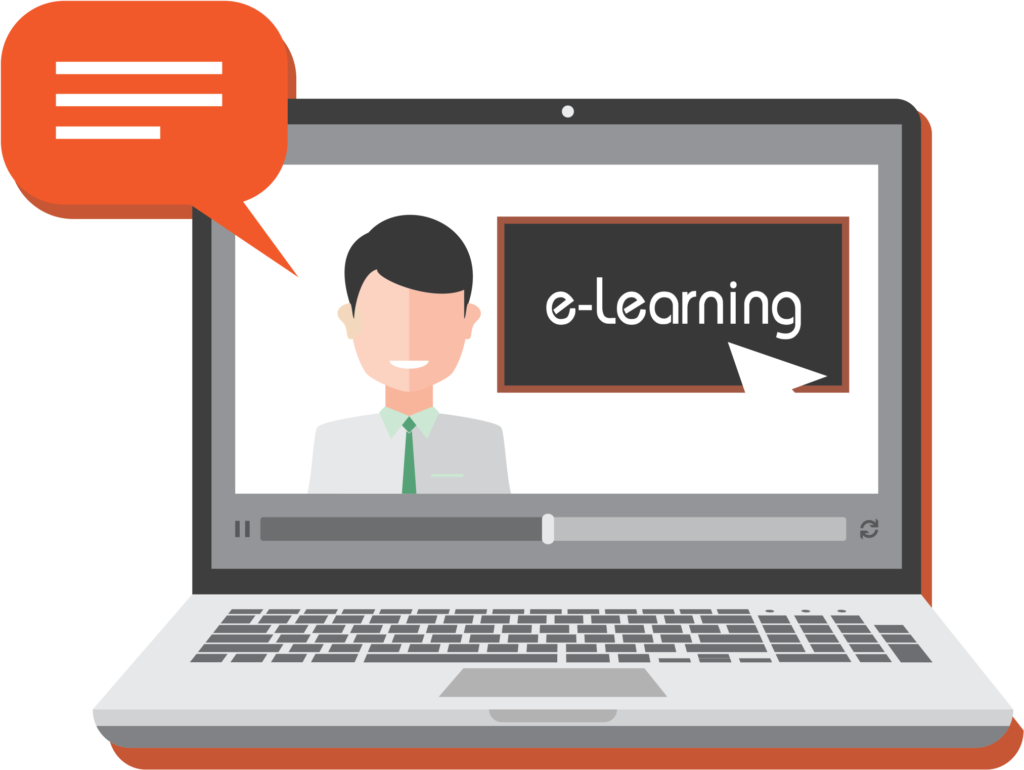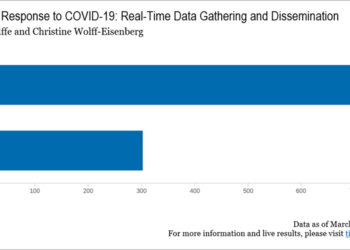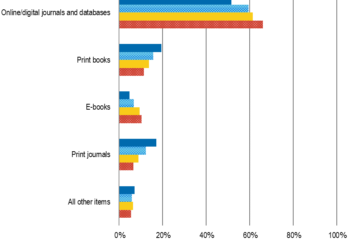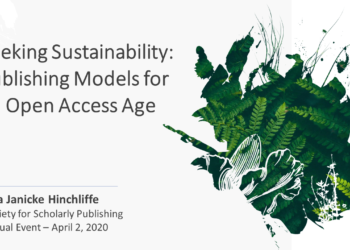Over the past month, the world has changed rather rapidly. Organizations have had to close their physical facilities and move to virtual operations, practically overnight. We are fortunate to have the technology in place to be able to do this, something that would have been unthinkable a few decades ago. And yet with all of these tools, we are still scrambling. Normally, designing online delivery of classes, content, or services can take months or even years to be done properly, but now teachers, professors, and librarians are having to switch delivery of resources to a new mode of delivery in a matter of weeks, if not days. This transition has created myriad challenges related to approach, to infrastructure and tools, to policy, and to concerns around access and equity. And they are building the airplane as they are learning how to fly it. And we’re already two weeks into what could be a long flight.

This transition has impacted my own life, as it has affected many of yours, as my children began the process of online learning this week as Maryland schools have reopened online. After setting up my kids, while I work, I can also listen as my wife manages running the department she chairs as they navigate these issues at her university. There are big challenges and small that crop up every day in each of these environments.
To help our collective understanding of some of these issues, last Friday NISO hosted a special webinar program on Teaching and Learning Online: Innovation Under Pressure. A free recording of the program is available on the Cadmore Media platform. This program brought together library administrators and university administrative leaders who have been dealing with moving their institutions into an online-only structure for the past few weeks to share what they have learned. Speakers at the sessions included:
- Heather Reid, Dean of the Library at Berklee College of Music (bio)
- Derek Bruff, Director of the Center for Teaching, Vanderbilt University (bio)
- Michael Reese, Associate Dean/Director of Center of Educational Resources, Johns Hopkins University (bio)
- Jon Shaw, Associate Vice Provost and Deputy University Librarian, University of Pennsylvania (bio)
- Bryan Alexander, Independent Analyst and Consultant (bio)
- Polly Thistlethwaite, Interim University Dean for Library Services, City University of New York (CUNY) (bio)
Academic institutions were among the first institutions to scale back their activities and plan for transitioning to virtual activities. Most of the institutions that were represented in this discussion had taken proactive steps to shut down in-person activities. Several had continuity of service plans already developed or resources developed from previous experiences that they could draw upon. For example, the Berklee College of Music had to close for a week following the bombing at the Boston Marathon in 2013, since the College is located only a few blocks from the finish line of the marathon. CUNY was closed for several days following Hurricane Sandy in 2012 and at least one of the College’s libraries was badly damaged. Vanderbilt University had a mumps outbreak and the teaching resource center on campus had developed teaching continuity plans, which it now has put into use. Many institutions, like Johns Hopkins University, have many satellite campuses around the world, and they had shut down those campuses even before the corona virus began to spread in the US. In addition, early on before many institutions closed their main campus, they had to address the needs of the many international students on their campuses who were facing difficult choices about their family situations back at home.
Within this context, a great deal of support has been provided by institutions, educational technology support organizations, and libraries to help faculty move into this new environment. At Vanderbilt, the Center for Teaching has been exploring online teaching methodologies for several years. Derek Bruff distinguished between two groups of educators in this environment, those that are seeking to replicate their traditional classroom environment, while others who are more comfortable with technology and were more willing to be adventurous in this transition. While this current situation is driving the demand to move online quickly, “Quality online course design doesn’t center itself on Zoom.” Better learning experiences can be provided via asynchronous tools, low-bandwidth delivery of content, and social interactivity tools rather then the synchronous video experiences that people have jumped most quickly towards. Of course, this is what was most comfortable and easiest to replicate from the professor’s perspective, if not the most effective for the students. To be fair, most of these transitions were made over a period counted in days. Bryan Alexander rightly commended all the work of the instructional designers supporting the educators, as we well as the institutional IT staff that made this transition possible. There is certainly a recognition of what is possible now might not be the best possible experience, but it is the best achievable experience and that should be acknowledged.
The beginnings of some best practices were discussed in terms of approaches to support these transitions. While some organizational implementation guides had been produced, in the scramble, these resources were not always easily discoverable in the rush, nor as clear as they could be in the present environment. Organizations like Vanderbilt and Hopkins identified partners among the faculty who could work as “deputies” or ambassadors in their departments and provide outreach to their colleagues who might need additional support. The University of Pennsylvania undertook faculty focus groups with their resource guides, so that they could address questions early on and revise the information guides that they had already written. Information resources were embedded in the course management tools, so that they were easily discoverable at the point of need for faculty.
As with any rapid transition, many issues came to light quickly in the process, such as security and privacy. Much has been made of the security and privacy concerns of the Zoom platform, although some of these challenges are not new, nor particular to Zoom or its settings. Libraries and schools obviously need to be vigilant in protecting their students and faculty. Sadly, there are no lengths that people won’t go to create mischief. The latest manifestation is Zoombombing, in which uninvited participants to a meeting disrupt things with tasteless, vile, or offensive content during the meeting. The University of California at Berkley Information Office has a great resource outlining ways that Zoom meeting users can thwart these attacks.
Another important issue to face is that of access and equity. Not every home has devices capable of supporting multi-media interactions, nor the bandwidth necessary to participate in synchronous online activities. A great number of Americans rely on online access via public libraries, which for safety reasons are (or should be) shuttered. While some schools provide computers to students, and many universities require them, access to technology is not as ubiquitous as we often presume. Consuming online courses or PDF course materials via a person’s phone is certainly less than ideal. In addition, these resources often require a cellular data plan that could become significantly priced using high-bandwidth tools like live video presentation of courses.
Another set of issues arises out of intellectual property rights issues that some institutions are facing. There are, of course, the traditional set of access and reuse rights issues around content that have been with us for years, such as course reserves and open access. Many publishers, both scholarly and news publishers, have been making their COVID-19 content freely available. Several tool providers are similarly making traditionally paid resources available for free. As we have moved delivery of content online, there are other issues that now present themselves. For example, music students at Berklee are facing barriers to performances, which now are not possible in person but streamed online, which require entirely different rights. Actors and stage productions might be licensed for in-person performances but may not be streamed for online viewing. Polly Thistlethwaite stressed that this is an opportunity to drive some more fundamental changes in how institutions function, how they license content and tools, and how institutions support learning and engagement on their campuses.
Building on this, Jon Shaw recognized that while we are moving rapidly, this isn’t the best way to run a pilot phase for any new technology. We are in a stage where new tools and approaches are being put into place out of necessity, but are these tools best suited for purpose in the end is an open question. How can we and should we track the usage and success of these tools that are being adopted in this transition phase? At some point we will need to determine which of these tools get more permanently adopted or let go of. How should we collectively assess these things that we are rushing to adopt when our needs are greatest?
Realistically, this crisis is beginning to look like it will extend more then a few weeks and it could be with us into the longer term. The conversation then turned toward those implications for institutions and learning long term. Some institutions, anecdotally, are reviewing their practices at this stage for how things might be structured in the fall if either the pandemic doesn’t improve quickly or if the virus begins a resurgence. Budgets at the national, state, and local levels are all being squeezed simultaneously by the economic downturn, but also by the increase in social support costs. The expectation is that this will cause a squeeze in educational budgets next year.
Bryan Alexander noted that futurists have been scenario-planning pandemic situations for decades. And yet, it seems this crisis has taken us unawares. While we all hope for the best, there need to be preparations in place for the worst case scenarios and the higher education community must have plans for the possibility that this will extend into the fall. We may need to deal with a situation in which people will have to be tempted back to campuses, because of either continued viral spreading or simply fear of a resurgence and concern that large public gatherings are not safe absent widespread testing or a vaccine. Online delivery of content may be here to stay for an extended period regardless of the path of the pandemic.
Going back over the conversation today, I reflect on how we all hope that a medical solution for treating the pandemic is identified as soon as possible. Most importantly for everyone’s health and safety, but also for a return to the normalcy of teaching and learning in-person. As I prepare my children for another day of their own home schooling, I experience so many of these challenges, and yet recognize that many others have many more challenges then I do right now. We need to make this experience better for everyone. The goal of the meeting and making the recording available for free is that we can learn from each other about how we can help accomplish that.
Discussion
1 Thought on "How are Academic Institutions Innovating Under Pressure"
Those who are scrambling might consider the Khan Academy approach. Here the class views one of Salman Kahn’s sequential 10 minute videos, which provide a basis for discussion the following day (https://www.khanacademy.org/). No scrambling, because Khan has already done the spadework. And if you do not agree, well, that is something to bring up in the discussion.



